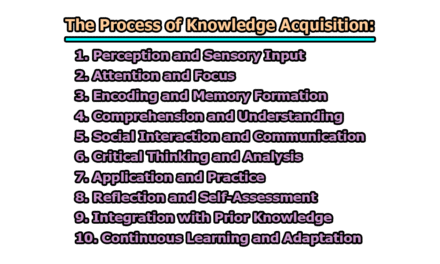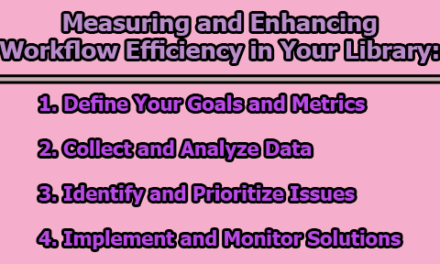Four Key Modules in Library Automation:
Library automation involves the use of technology and software to streamline various library processes and services. Four key modules in library automation are Acquisition, Processing, Circulation, and Serials Control. Here’s an overview of each module:
1. Acquisition Module: The Acquisition Module in library automation is a crucial component that streamlines the processes involved in acquiring new materials for a library’s collection, whether through purchase, donation, or exchange. This module helps library staff manage the entire acquisition workflow efficiently, from the initial selection of materials to their arrival and payment. Here’s a brief breakdown of the Acquisition Module:
1.1 Selection:
a) Purpose: The acquisition process begins with the selection of materials to be added to the library’s collection. This phase involves making informed decisions about which books, journals, multimedia, or other resources to acquire.
b) Functions:
- Collection Development: Librarians and collection development specialists use this module to evaluate the library’s collection needs. They consider factors like subject areas, user preferences, budget constraints, and collection policies.
- Recommendations: Staff can generate lists of recommended materials based on criteria such as user requests, circulation statistics, and reviews from professional sources.
- Budget Planning: The acquisition module helps in allocating budget resources to different subject areas or departments based on collection priorities.
1.2 Ordering:
a) Purpose: Once materials are selected, the next step is to initiate the ordering process with vendors, publishers, or suppliers.
b) Functions:
- Vendor Information: Maintain vendor details, including contact information, terms, and preferred methods of communication.
- Create Orders: Library staff can create and manage orders for individual items or multiple copies of the same item. They specify quantities, editions, formats, and other relevant details.
- Electronic Ordering: Many libraries use electronic ordering systems to transmit orders directly to suppliers, reducing manual paperwork.
- Order Tracking: Monitor the status of orders, including order confirmation, shipment, and delivery dates.
- Cancellation: If necessary, orders can be canceled or modified.
1.3 Budget Management:
a) Purpose: Efficient budget management is essential to ensure that the library stays within its allocated financial resources.
b) Functions:
- Budget Allocation: Allocate funds from the library’s overall budget to specific acquisition categories, such as books, journals, electronic resources, etc.
- Budget Monitoring: Track expenditures against allocated budgets to ensure that the library remains within budget constraints.
- Financial Reporting: Generate reports that provide an overview of spending patterns and remaining budget balances.
1.4 Receipt and Invoice Processing:
a) Purpose: This phase involves the physical receipt of materials ordered and the processing of invoices for payment.
b) Functions:
- Receiving Materials: Verify the receipt of physical materials and compare them to the order details to ensure accuracy.
- Invoice Verification: Cross-reference invoices received from vendors with the initial order details. Confirm that the materials match the order and pricing agreements.
- Payment Processing: Initiate payments to vendors based on verified invoices, either electronically or by generating payment vouchers.
The Acquisition Module plays a pivotal role in ensuring that a library’s collection remains current, relevant, and aligned with the needs and interests of its patrons. By automating and centralizing these processes, libraries can enhance efficiency, reduce errors, and make more informed decisions about resource allocation. Additionally, it provides valuable data for collection development and budget planning.
2. Processing Module: The Processing Module in library automation is a critical component that handles the organization and cataloging of library materials, ensuring that they are properly prepared and integrated into the library’s collection. This module is essential for making items easily discoverable and accessible to library patrons. Here is a brief overview of the Processing Module:
2.1 Cataloging:
a) Purpose: Cataloging is the process of creating detailed records for each item in the library’s collection, making it possible for users to search and find materials efficiently.
b) Functions:
- Record Creation: Library staff create cataloging records for each item, which typically include bibliographic information such as title, author, publisher, publication date, ISBN/ISSN, subject headings, and more.
- Standardized Formats: Cataloging adheres to standardized formats such as MARC (Machine-Readable Cataloging) to ensure consistency and compatibility with library systems.
- Authority Control: Maintain authority files to ensure consistent and accurate subject headings, names, and other access points.
2.2 Classification:
a) Purpose: Classification involves assigning a call number or code to each item to organize materials on the library shelves systematically.
b) Functions:
- Dewey Decimal or Library of Congress: Depending on the library’s classification system, staff assigns a call number that reflects the subject matter of the item.
- Shelving Location: Determine the physical location where the item will be shelved, ensuring that it is easily retrievable by patrons and staff.
2.3 Labeling and Barcoding:
a) Purpose: Labels and barcodes help staff identify and track library materials efficiently.
b) Functions:
- Call Number Labels: Apply labels with the assigned call numbers to the spine or cover of books and other physical materials.
- Barcoding: Attach barcode labels to items for quick and accurate circulation and inventory management.
- RFID (Radio-Frequency Identification): Some libraries use RFID tags for more advanced tracking and security.
2.4 MARC Records:
a) Purpose: MARC records are machine-readable cataloging records that provide a standardized format for bibliographic information.
b) Functions:
- Record Maintenance: Update and manage MARC records to reflect changes in the library’s collection, including additions, withdrawals, and updates.
- Interlibrary Loan: Share MARC records with other libraries to facilitate interlibrary loan services.
2.5 Item Processing:
a) Purpose: Ensure that physical materials are in proper condition and ready for circulation.
b) Functions:
- Spine Labeling and Covering: Apply protective coverings to book jackets and add spine labels for easy identification.
- Security Strips: Insert security strips or tags to prevent theft and unauthorized removal of materials.
- Rebinding and Repair: If necessary, perform bookbinding and repair tasks to extend the lifespan of materials.
The Processing Module plays a fundamental role in ensuring that library materials are well-organized, discoverable, and accessible to patrons. By automating these processes, libraries can reduce errors, save time, and improve the overall quality of their collections. Additionally, standardized cataloging and classification practices enhance the user experience by making it easier for patrons to locate and retrieve materials.
3. Circulation Module: The Circulation Module in library automation is a vital component that manages the borrowing and returning of library materials by patrons. This module is designed to streamline circulation-related processes, enhance user services, and maintain accurate records of item availability. Here is a brief overview of the Circulation Module:
3.1 Check-Out and Check-In:
a) Purpose: The primary function of the circulation module is to facilitate the borrowing and returning of library materials.
b) Functions:
- Check-Out: Library staff use this feature to record the issuance of materials to patrons. They scan or input the barcode or RFID tag of the item and the patron’s library card.
- Due Dates: The system calculates and assigns due dates based on library policies (e.g., loan periods, renewals, and fine rules).
- Check-In: When patrons return materials, staff or self-check-in kiosks scan or input the items to update their status as available for circulation.
3.2 Hold Requests:
a) Purpose: Patrons can request to borrow items that are currently checked out by others, ensuring they have priority when the item becomes available.
b) Functions:
- Placing Holds: Patrons can place hold requests for specific items either in person at the library or through the library’s online catalog.
- Notification: When a held item is returned and available for check-out, the system automatically generates notifications to inform the requesting patron.
3.3 Renewals:
a) Purpose: Patrons often have the option to extend the loan period for items they have borrowed.
b) Functions:
- Renewal Requests: Patrons can request renewals online or in person, subject to library policies and availability.
- Renewal Limits: Libraries can set limits on the number of renewals allowed for each item and the total length of the extended loan period.
3.4 Fines and Fees:
a) Purpose: To manage and collect fines and fees for overdue materials and other library services.
b) Functions:
- Overdue Notices: Automatically generate and send overdue notices to patrons via email or postal mail.
- Fine Calculation: Calculate and track fines based on library policies (e.g., daily late fees, maximum fines, and grace periods).
- Payment Processing: Allow patrons to pay fines and fees at the circulation desk or through an online portal.
3.5 Patron Records:
a) Purpose: Maintain accurate patron information and transaction history.
b) Functions:
- User Registration: Create and update patron records, including contact information and library card details.
- Transaction History: Maintain a record of items checked out, due dates, renewals, and fine payments for each patron.
- Privacy Controls: Ensure patron confidentiality and compliance with data protection regulations.
3.6 Item Reservations:
a) Purpose: Enable patrons to reserve items in advance, ensuring they are available when needed.
b) Functions:
- Reserve Requests: Patrons can request to reserve specific items that are currently available, but they want to ensure their availability for future check-out.
The Circulation Module is central to providing efficient and user-friendly services in a library. By automating circulation-related tasks and maintaining accurate records, libraries can improve patron experiences, reduce administrative burdens, and ensure the smooth management of their collections. Additionally, the module provides valuable data for analyzing patron borrowing habits and optimizing collection development.
4. Serials Control Module: The Serials Control Module in library automation is a specialized component designed to manage and maintain a library’s periodical and serials collections. This module is crucial for libraries that subscribe to magazines, journals, newspapers, and other publications, as it helps streamline the acquisition, organization, and access to these materials. Here is a brief overview of the Serials Control Module:
4.1 Subscription Management:
a) Purpose: The primary function of this module is to oversee the library’s serials subscriptions, ensuring that they are current and meet the needs of library users.
b) Functions:
- Subscription Tracking: Maintain a comprehensive database of all serials subscriptions, including information about titles, publishers, subscription periods, and renewal dates.
- Subscription Renewals: Monitor and manage the renewal process to ensure that subscriptions are not interrupted.
- Cancellation: Facilitate the cancellation of subscriptions for titles that are no longer needed or relevant.
4.2 Issues Management:
a) Purpose: Keep track of individual issues of serials, such as journals and magazines, to ensure they are received, processed, and made available to patrons.
b) Functions:
- Issue Recording: Record information about each issue, including volume and number, publication date, and location within the library.
- Claims for Missing Issues: Automatically generate claims for missing issues from publishers to ensure timely receipt.
- Routing and Processing: Direct issues to appropriate library departments for processing, cataloging, and shelving.
4.3 Serials Check-In:
a) Purpose: This function ensures that each issue of a serial is properly checked in upon receipt and is made available for circulation.
b) Functions:
- Check-In Records: Record the receipt of each issue, updating the status of the issue in the library’s catalog.
- Holding Records: Manage information about the library’s holdings for each serial title, indicating which issues are available and which are not.
4.4 Usage Statistics:
a) Purpose: Gather data on the usage of serials to inform collection development decisions.
b) Functions:
- Circulation Statistics: Record and report on the circulation of individual serial issues, providing insights into the popularity of different titles.
- Electronic Resource Usage: Track online access to digital serials and electronic journals.
- Cost Analysis: Analyze the cost-effectiveness of serials subscriptions by comparing usage to subscription fees.
4.5 E-Journal Management:
a) Purpose: Libraries often subscribe to electronic journals, and this function helps manage access to digital serials.
b) Functions:
- Access Management: Maintain information on electronic journal subscriptions, including authentication and access URLs.
- Proxy Configuration: Set up proxy servers or authentication systems to ensure remote access to e-journals for authorized library users.
The Serials Control Module is essential for libraries with extensive serials collections, as it allows for efficient management of subscriptions, timely access to serials, and data-driven decisions regarding the continuation or cancellation of subscriptions. This module plays a crucial role in ensuring that library users have access to the most up-to-date and relevant periodical materials.
From the above discussion, we can say that these modules, when integrated into a library’s automation system, help improve efficiency, accuracy, and user services, allowing libraries to better manage their collections and serve their patrons effectively.

Library Lecturer at Nurul Amin Degree College










